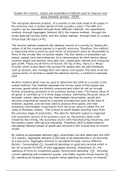Explain the income,output and expenditure methods used to measure real
gross domestic product (GDP)
The real gross domestic product of a country is the total value of all output in
the economy over a certain period of time (usually a year). The GDP of a
country can be calculated through three different methods: the expenditure
method, through Aggregate Demand (AD), the income method,through the
Gross National Income (GNI), and the output method,through total (X) output
minus total (M) input (X-M).
The income method measures the national income of a country by finding the
values of all the incomes earned in a specific economy. Therefore, this method
is measuring what is earnt by each factor of production given by households to
firms in the circular flow of income model. The four factors of production are
labour, capital, land and enterprise. As a remuneration for their service labour
receives wages and salaries, land gets rent, capital gets interest and enterprise
gets profit. These are all forms of income. On top of this, there is a 'Mixed
Income' which is also taken into account for people who are self employed,
such as doctors, who manage their own labour and capital. The total of all the
various forms of incomes is called the National Income, a method to calculate
GDP.
Another method which may be used to determine the GDP of a country is the
output method. This method calculates the money value of final goods and
services, goods which are directly consumed and which do not go through
further processing, produced in an economy during a year. The money value of
all goods is summed up in a three stage process: estimating the gross value of
domestic output, determining the intermediate consumption, goods and
services consumed as inputs by a process of production such as the cost of
material, supplies, and services used to produce final goods, and then
deducting intermediate consumption from the gross value to obtain the net
value of domestic output。 This is done to avoid double counting input from
the previous stage of production。The data for domestic output is organised
into production sectors of an economy, such as, the primary sector with
industries like mining, the secondary sector with manufacturing industries, and
the tertiary sector with service industries. Therefore, GDP is determined by
calculating National output of goods and services in the circular flow of income
model.
By looking at aggregate demand (AD), economists can also determine the GDP
of a country. Aggregate demand is the total of all expenditures in an economy
at a give price. Aggregate demand is calculated through various different
factors:Consumption (C), household spending on good and services which in
the UK accounts for 65% of total aggregate demand, Investment (I), the
spending of firms on investment goods, Government spending (G) including
current spending and investment goods,and finally exports minus imports (X-
M), spending by foreigners on exports minus spending by country on imports





